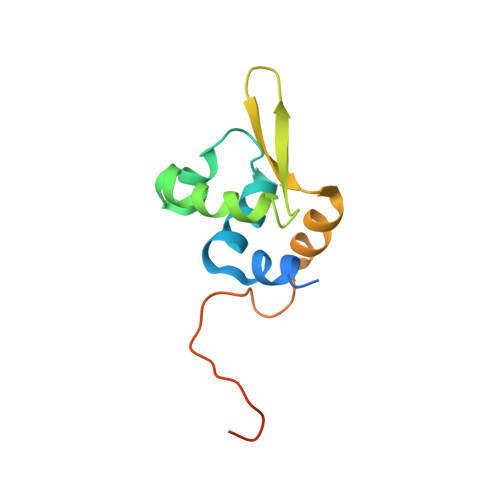NMR Structural Analysis of Cadmium Sensing by Winged Helix Repressor CmtR.
Banci, L., Bertini, I., Cantini, F., Ciofi-Baffoni, S., Cavet, J.S., Dennison, C., Graham, A.I., Harvie, D.R., Robinson, N.J.(2007) J Biol Chem 282: 30181-30188
- PubMed: 17599915
- DOI: https://doi.org/10.1074/jbc.M701119200
- Primary Citation of Related Structures:
2JSC - PubMed Abstract:
CmtR from Mycobacterium tuberculosis is a winged helical DNA-binding repressor of the ArsR-SmtB metal-sensing family that senses cadmium and lead. Cadmium-CmtR is a dimer with the metal bound to Cys-102 from the C-terminal region of one subunit and two Cys associated with helix alphaR from the other subunit, forming a symmetrical pair of cadmium-binding sites. This is a significant novelty in the ArsR-SmtB family. The structure of the dimer could be solved at 312 K. The apoprotein at the same temperature is still a dimer, but it experiences a large conformational exchange at the dimer interface and within each monomer. This is monitored by an overall decrease of the number of nuclear Overhauser effects and by an increase of H(2)O-D(2)O exchange rates, especially at the dimeric interface, in the apo form with respect to the cadmium-bound state. The C-terminal tail region is completely unstructured in both apo and cadmium forms but becomes less mobile in the cadmium-bound protein due to the recruitment of Cys-102 as a metal-ligand. DNA binds to the apo dimer with a ratio 1:3 at millimolar concentration. Addition of cadmium to the apo-CmtR-DNA complex causes DNA detachment, restoring the NMR spectrum of free cadmium-CmtR. Cadmium binding across the dimer interface impairs DNA association by excluding the apo-conformers suited to bind DNA.
Organizational Affiliation:
Department of Chemistry and Centro Risonanze Magnetiche, University of Florence, Via Luigi Sacconi 6, Florence 50019, Italy.















